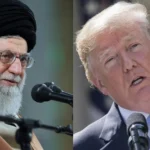TRAFFIC BACKED UP
Traffic congestion was evident on the highways departing from the capital city of Tehran, which is home to 10 million residents, as individuals sought refuge in other areas.
Arezou, a 31-year-old resident of Tehran, communicated with Reuters via phone, stating that she had successfully reached the nearby resort town of Lavasan.
“We will remain here for as long as this war persists. My friend’s residence in Tehran was struck, and her brother sustained injuries. They are innocent civilians,” she remarked. “Why must we bear the consequences of the regime’s choice to pursue a nuclear program?”
In Israel, sirens sounded, alerting citizens to potential retaliatory missile strikes from Iran. At the Ramat Gan city train station, located east of Tel Aviv, individuals were lying on mattresses provided by the city, which were arranged on the floor, or sitting in makeshift camping chairs, with plastic water bottles scattered around.
“I feel frightened and overwhelmed. Particularly because I reside in a densely populated area that appears to be a target for Iran, and our city contains many old buildings that lack shelters and safe spaces,” expressed Tamar Weiss, holding her four-month-old daughter tightly.
Iran has been considering various strategies for leverage, including subtle threats to disrupt the global oil market by limiting access to the Gulf through the Strait of Hormuz, recognized as the most crucial shipping route for oil worldwide.
Oil prices surged by 9% on Friday and have continued to rise throughout this week. The CEO of the Italian energy firm Eni (ENI.MI) indicated that the increases observed thus far were still manageable, suggesting an anticipation that significant disruptions would be avoided.
Ehsan Khandouzi, a former Iranian economy minister, stated on X that Iran ought to begin requiring tankers to secure permission for passage through the strait. The Oil Ministry and Foreign Ministry of Iran did not promptly reply to requests for comments.
FILMING RESTRICTIONS
Within Iran, the authorities are focused on averting panic and shortages. There has been a notable decrease in the circulation of images depicting destruction compared to the initial days of the bombing, when state media broadcasted visuals of explosions, fires, and destroyed buildings. A prohibition on public filming has been enacted.
The government has imposed restrictions on the quantity of fuel that can be purchased. Oil Minister Mohsen Paknejad informed state television that these limitations are intended to avert shortages, assuring that there would be no issues in supplying fuel to the populace.
Iranian officials have reported a minimum of 224 fatalities due to Israeli attacks, primarily among civilians, although this figure has not been updated in several days.
In Israel, the missile strikes from Iran represent the first instance in decades of a shadow war and proxy conflict where a considerable number of projectiles launched from Iran have breached defenses, resulting in casualties among Israelis in their residences.
Since Friday, Iran has launched approximately 400 missiles at Israel, with around 40 successfully penetrating air defenses, leading to the deaths of 24 individuals, all of whom were civilians, as reported by Israeli authorities. With the deaths of Khamenei’s principal military and security advisors, the leader’s inner circle has become more restricted, increasing the likelihood of strategic miscalculations, according to five individuals acquainted with his decision-making process.
Throughout the Gaza conflict, Israel has inflicted significant damage on Iran’s regional allies, Hamas and Hezbollah, thereby constraining Tehran’s capacity to retaliate through attacks by its proxy fighters near Israeli borders. Syrian leader Bashar al-Assad, who was supported by Iran during 13 years of conflict, was ousted last year.



